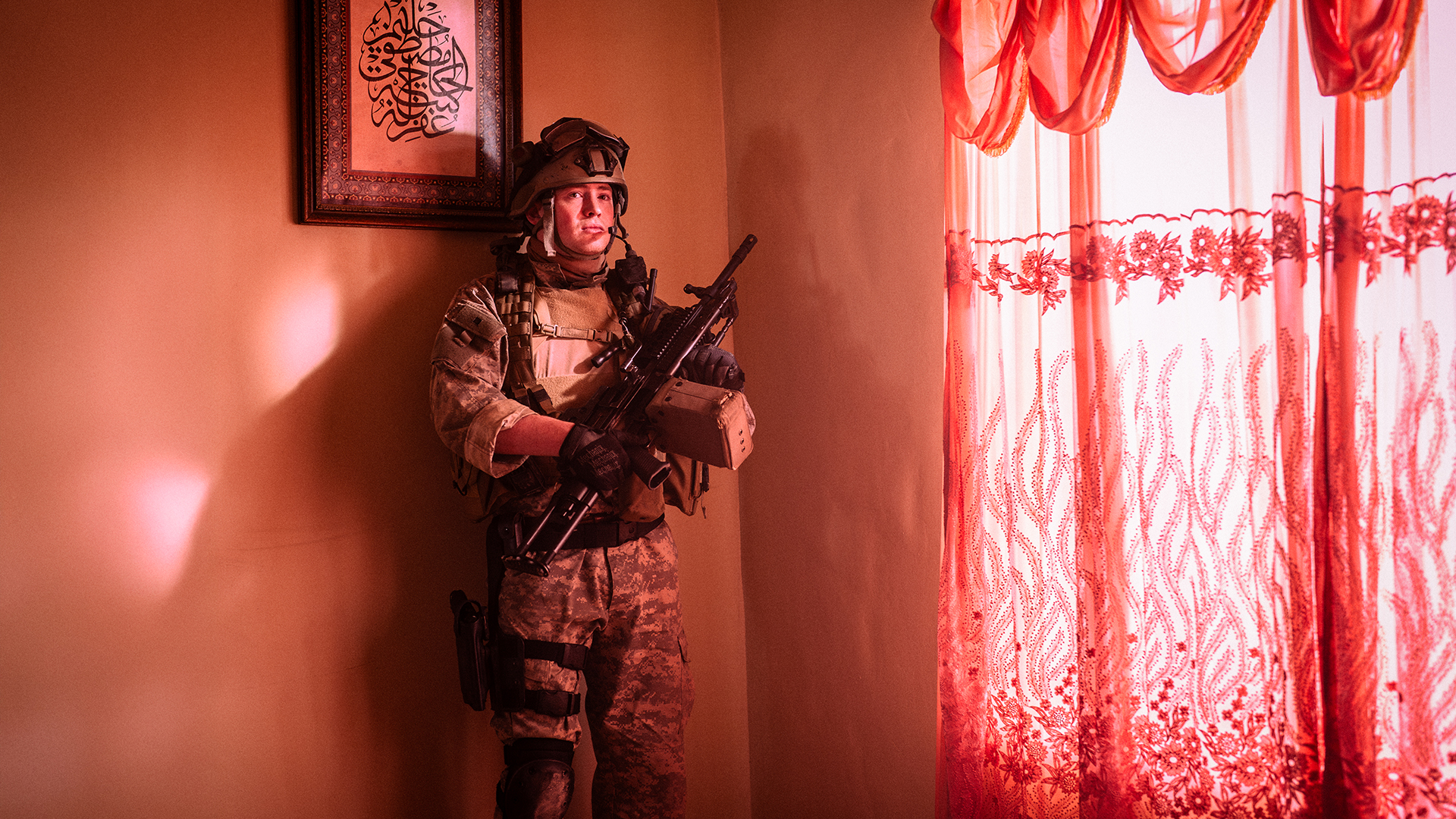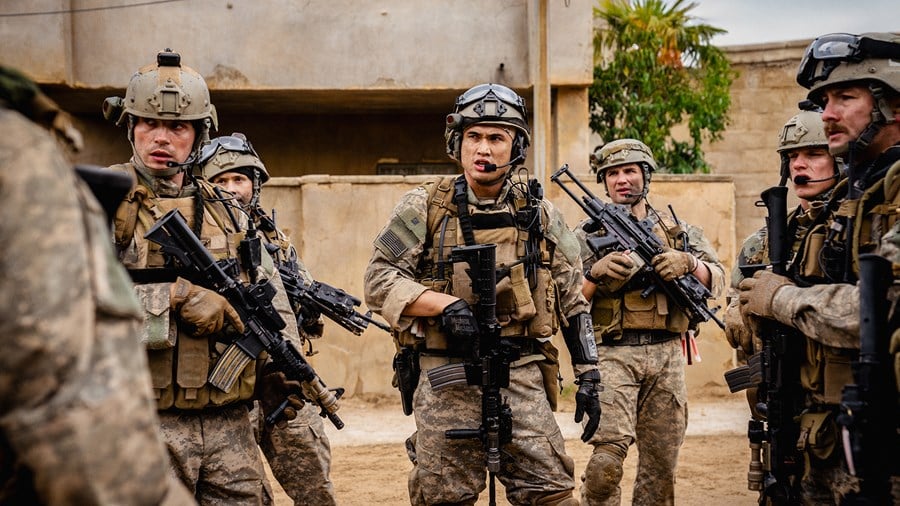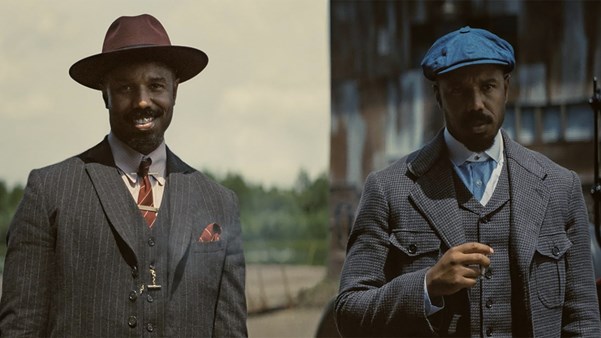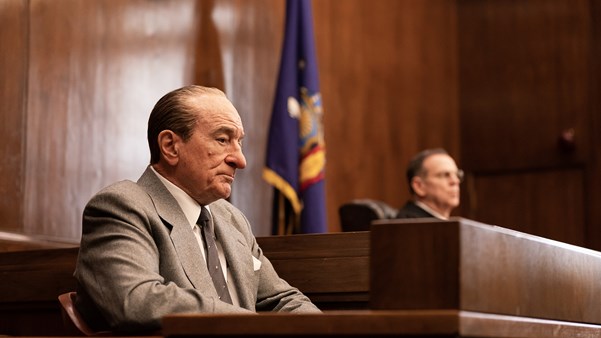There is no musical score in Warfare, a visceral tale of an American Navy Seal mission gone wrong in enemy territory, co-directed by Iraq veteran Ray Mendoza and Alex Garland. The soundscape is instead dominated by the bleak, uncomfortable and punishingly loud noises of gunfire, bombs and the blood-curdling screams of men at war.
As a technical feat, it’s an impressive achievement. We spoke to the film’s Oscar-winning sound editor Glenn Freemantle (Slumdog Millionaire, 2009; Gravity, 2014) about how he and his team helped to plunge us into the harsh reality of war.

AMON WARMANN: What does your job look like on a day-to-day basis on a film like this?
GLENN FREEMANTLE: It starts off when we have the first meetings with Alex, where we break the film down into lots of bits. They’re about making sure we’re able to get everything 100% real, how we’ll do it and where we’ll source the sounds. We figure out where we are each time, and then we talk about it again. It’s a way of making it the best we possibly can. Sometimes you’re not on it. Some days you look at it and go, ‘We’ve got to do that again.’ It’s a constant flow of thoughts.

AW: How often are you on set?
GF: Not very often, because it’s boring! [laughs] I did visit the Warfare set when they were shooting. It was really important to see the scale of the place, because they built the whole street – and the house as a proper house – which made it really interesting to shoot in. All the actors were in military mode 24/7 when you talked to them. You really got a sense of what it was like to be in that environment. Sound is one thing, but feeling is just as important.
AW: You’ve worked on all of Alex Garland’s films, and Ray Mendoza – an Iraq veteran who you also worked with on Civil War [2024] – is a co-director here. What were your conversations like with them?
GF: Alex doesn’t beat around the bush, and he’s very articulate. Because Ray was there and he knew everything that happened, he was a form of knowledge that we abided by 100%. He was invaluable. The two of them together were a really great fit.

AW: I read Ray had a speaker system with a library of ambient sounds that he would control through his iPhone…
GF: That’s right. We supplied a load of sounds, and he would play them to get the actors to evoke the feeling of what it would be like. It was helpful to figure out how to talk against that amount of noise. A lot of films get that wrong. You have to shout when it’s all going on.
One of the things we learned from Ray is what the soldiers hear and how they hear it. In this film, you hear a lot of snaps. Not just bangs, but the snap of the gun. That’s the bullet breaking the sound barrier. So they hear the snap, and that’s what they follow. It was part of their military training for how to move and gain control over an area straight away. It was not only great sound-designing work to do with the whole team, but also great knowledge from someone who’s been there in this situation.

AW: What other sounds did you capture from the set?
GF: They had all the tanks there, so I went down with the team and we put about 20 microphones on them so we could have every angle. We recorded intakes in the engines, on the tracks, the inside, the exterior, the exhaust, everything.
When it’s real, it’s unbelievably loud. The guns are powerful. It’s chaotic and it’s messy. The gunshots have an impact, and we try to replicate that in the cinema, so you feel the weight of it in your chest as well as in your ears. We’re not trying to be a Hollywood war. This isn’t that. Which is why when it’s quiet, it’s quiet. We’re not trying to fill gaps with stuff that we don't need. On a lot of films, we’d have to worry about that. I feel privileged to be asked to work on a movie without music. The big effect for me was that I didn’t miss it. There’s no music telling you to feel sad or scared – the drama and the intensity is within the story.

AW: One of the most powerful sounds in the film is the ‘show of force’, when a jet swoops down and creates a shockwave.
GF: The idea of it was to scare people. It’s breaking the sound barrier, so we hit that sound break – that’s the light explosion of sound that hits. And then just as the jet goes, the second wave hits. It’s so close, you’ve got to make it really big. We get the big bass in and then let it kick out. Because it’s so powerful and moves so much air, it shakes all the buildings, too. We mixed in Dolby Atmos and we used every tool in the box to create that world that they’re in.
AW: Is it a big readjustment for you to go from an Alex Garland film, where it's all real, authentic chaos, to something more Hollywood-ised?
GF: In any job, you have to look at the job in front of you – what it needs and what it wants to be. It’s always good to be real when you can. But in some films, you’re going to take liberties because of how the film is shot, or the different stuff flying through the air. A car going through an airport is not going to sound like anything in this film.
WATCH WARFARE IN CINEMAS




